MANAGEMENT...
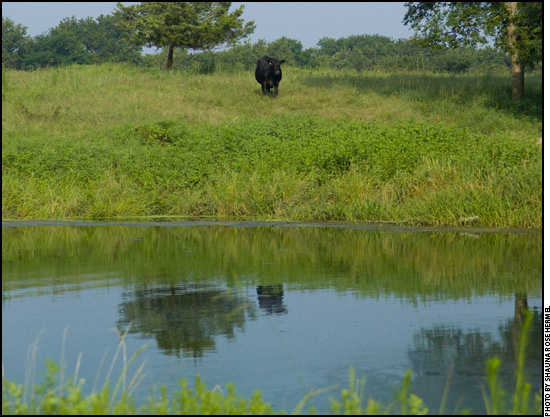
Preparation is the Key
For Winter Pond Management
It is that time of year when ponds are steaming early in the mornings with a visible fog that unmistakably signals that fall is upon us. As the pond cools with the chill in the air, pond owners have some preparation work necessary to be able to enjoy a well-deserved winter's rest in the coming months.
"Fall and spring are good times to mow the dam, if slopes are gentle enough to do so safely," said Marley Beem, Oklahoma State University (OSU) Cooperative Extension aquaculture specialist. "Inspect for animal burrows and eliminate any animals digging into your dam." Read more.
BQA Program Spans Pasture to Processing
K-State connects beef producers with online training resources.
A series of online videos hosted by Kansas State University (K-State) can help beef producers and processors keep pace with changes in most every step of the production cycle.
As part of its Beef Quality Assurance (BQA) Program, K-State's Beef Cattle Institute (BCI) has expanded to an additional website, "Animal Care Training." The BQA Program is a training system for beef producers, handlers and processors.
Dan Thomson, an associate professor in the Department of Clinical Sciences in K-State's College of Veterinary Medicine and director of K-State's BCI, said the program fills gaps created by dwindling resources and educates workers in all sectors of the beef industry, from the newly hired to the seasoned veteran. Read more.
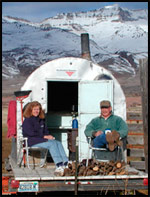
Ron Torell with his wife, Jackie
Cow Camp Chatter
The ranch boneyard
We've all heard the old cliché that one man's junk is another man's treasure. Nowhere is this more evident than when strolling through a ranch boneyard. The ranch boneyard is a place where worn-out haying equipment, old automobiles, damaged panels, manual chutes and basically any other piece of ranch equipment, scrap metal or wooden object that was ever used, lie in wait to be called into service again. An old, worn-out piece of junk might one day be restored to its original form or transformed into something new and useful. In this edition of "Cow Camp Chatter" let’s discuss the importance of the ranch boneyard and how being frugal is essential to the economic survivability of ranching. Read more.
Nelson Ryegrass Outyields Gulf
The newly released ryegrass outyields TAM 90 and Prine, as well.
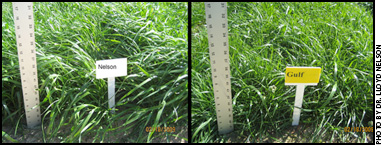 Pinching pennies when buying ryegrass seed for winter grazing is a bad business decision, says a Texas AgriLife Research scientist.
Pinching pennies when buying ryegrass seed for winter grazing is a bad business decision, says a Texas AgriLife Research scientist.
"Nelson" is a newly released ryegrass developed by Lloyd Nelson, AgriLife Research small-grains breeder. It has a higher yield potential than "primo" ryegrasses such as TAM 90, Prine and Jumbo, he says.
"And in South Texas, it's higher than Marshall. In more northern areas, it's not significantly higher than Marshall, but it's competitive," says Nelson, who also developed TAM 90 and TAMTBO, other high-yielding ryegrasses. Read more.
Reasons to Preg-Check
Most cow-calf producers who preg-check after breeding season do so to determine which cows to keep and which to cull, since they don't want to winter an open cow. It's also helpful for determining how to sort the cows. You might choose to wean a calf early and sell the open cow at peak market price in late summer, or keep her awhile to fatten if she's thin, according to Jeff Hoffman, a U.S. Department of Agriculture (USDA) veterinarian who had a large-animal practice at Salmon, Idaho, for many years.
"The other major reason to preg-test is that finding more than a typical number of open cows can alert you to a disease problem," he says. Trichomoniasis (trich), vibriosis (vibrio), infectious bovine rhinotracheitis (IBR), bovine viral diarrhea (BVD), and leptospirosis may cause cows to lose their pregnancies. Typically, the sexually transmitted diseases like trich and vibrio cause early abortion and the cow returns to heat, ending up open or calving very late. If bulls are left with cows all summer, some of these cows may become pregnant again. Finding you have a bunch of open or late cows is a little after the fact, but at least you'll know there's a problem and can take measures to correct it.
"Nutritional deficiencies in the herd may also show up as open cows, especially in second calvers. Most people feed yearling heifers adequately, and they breed up fairly well — but they are not raising a calf," Hoffman says. The 2-year-olds with calves at side are still growing, plus trying to feed their calf. That age group may end up with a high percentage open.
"Yearling heifers should always have a short breeding season (45 days, the equivalent of two heat cycles)," he says. This is the best age group to sort and cull for fertility and efficiency. Pregnancy-testing heifers soon after a relatively short breeding season is helpful because you should never keep a yearling that's a slow breeder (her fertility problem is probably genetic, rather than nutritional). You can then sell the open ones early when the market for them is best.

Kris Ringwall
Beef Talk
2010 CHAPS production benchmarks are in.
Each year, the North Dakota Beef Cattle Improvement Association (NDBCIA) summarizes the average performance of beef cattle herds that are utilizing the CHAPS programs. The NDBCIA has been keeping records since 1963 and presents these annual evaluations as five-year rolling benchmark values for average herd performance for several traits.
Through the years, individual producers compare their herd values to the overall averages. This allows producers to evaluate individual herd performance, discuss it and, perhaps, make changes. Much like setting personal goals, the group benchmarks allow producers to set goals and have a set of numbers as a guide to their goals. Read more.
New Products
Industry affiliates provide a wide array of products and services to assist you on the farm and ranch. Here's an assortment of new products to hit the market recently.
• Pregnancy test offers fast results
• Next-generation grinder mixer
• Baler that requires less horsepower
• Carted wheel rake with expanded capacity
• Military-inspired camouflage welding helmet
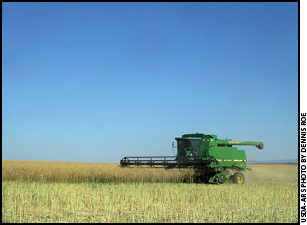
Winter canola being harvested in north-central Washington.
Benefits of Planting Winter Canola Examined
ARS scientists have developed effective production protocols for winter canola.
Winter canola might soon be the crop of choice for Pacific Northwest farmers, thanks to research by U.S. Department of Agriculture (USDA) scientists and their partners. The multitasking annual plant can be used to control weeds, supplement animal feed, produce biodiesel — and spark a new revenue stream for the Colville Confederated Tribes. Read more.
Facility for the Southwest
NMSU breaks ground on Southwest Center for Rangeland Sustainability.
New Mexico State University (NMSU) Sept. 28 broke ground on its Southwest Center for Rangeland Sustainability near Corona. When completed, the $1.5 million state-funded first phase will consist of indoor and outdoor multiuse meeting/exhibit areas; library/meeting room for outreach activities and student use; offices for the Corona research center, visiting faculty, staff and students; and a kitchen/meal preparation facility. These components will be spread throughout 3,450 square feet (sq. ft.) of enclosed space and 2,800 sq. ft. of covered porch area.
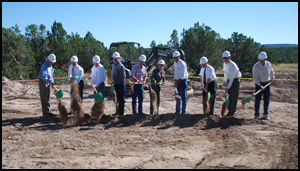
Because the new facility is centrally located in New Mexico, NMSU's Southwest Center for Rangeland Sustainability has garnered support from many statewide organizations, legislators and local governments, as well as the executive branch of the State of New Mexico. [NMSU photo by Audry Olmsted]
"This facility is going to open up a whole new world of outreach for us," said Shad Cox, ranch manager of the Corona Range and Livestock Research Center. The new building will be located on the research center's property. "We'll have something where, at a moment's notice, we can, in a more timely fashion, bring an educational event to the community and the state of New Mexico." The center is also intended to provide a rich learning environment for NMSU students. Read more.
Angus Advisor
Click here for October herd management tips from cattle experts across the nation. Advice separated by region.
[Click here to go to the top of the page.]




